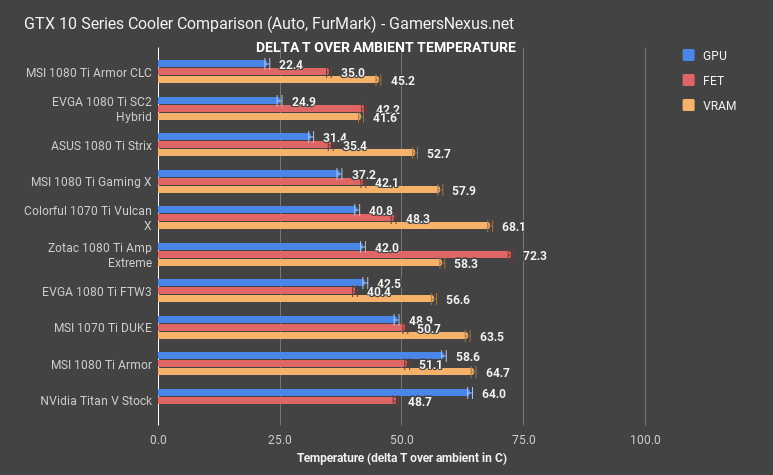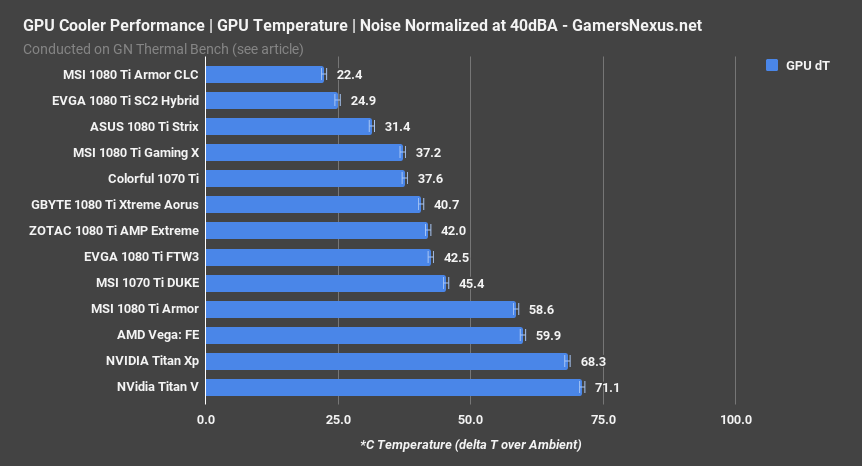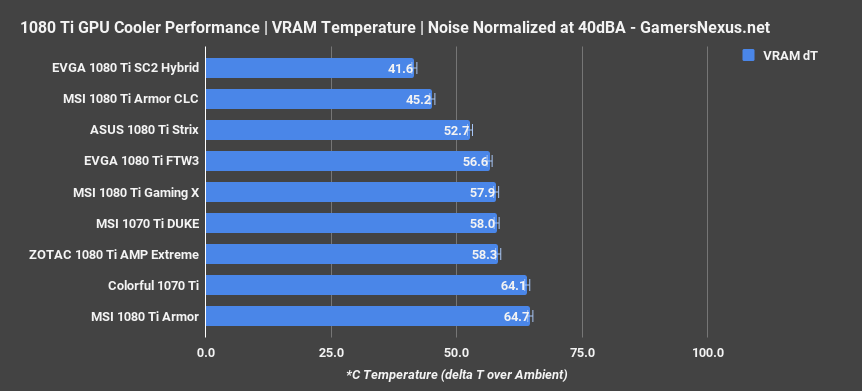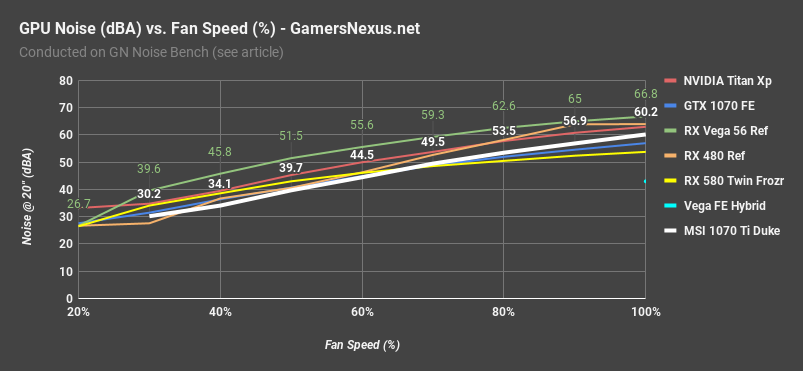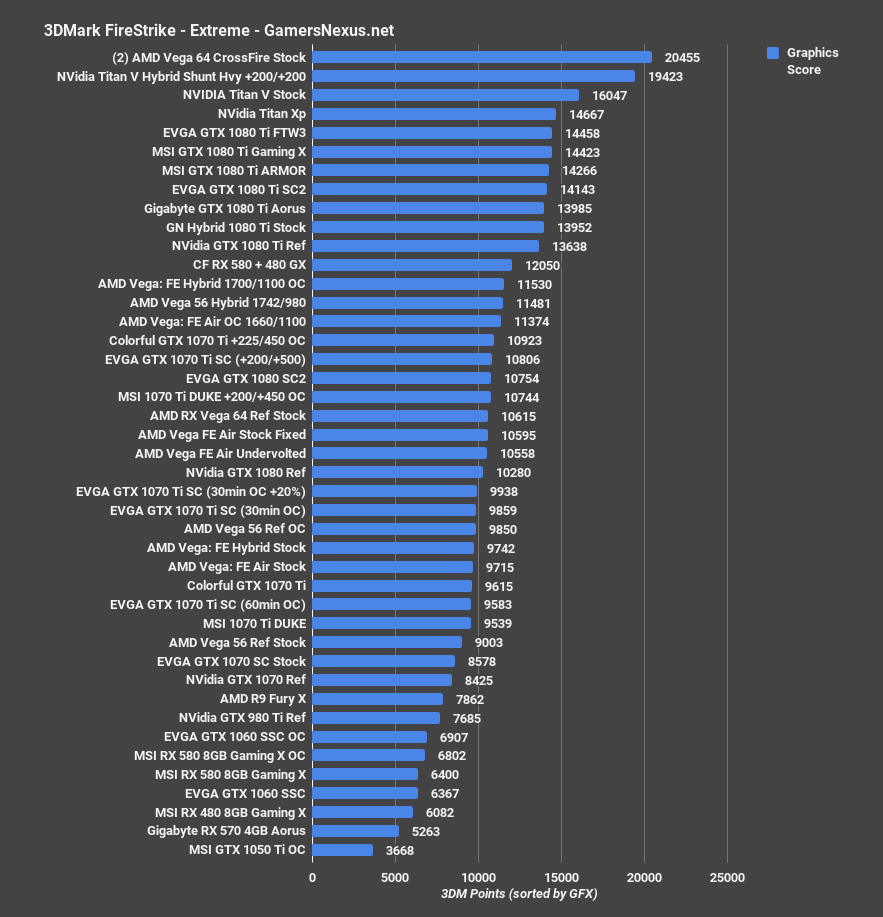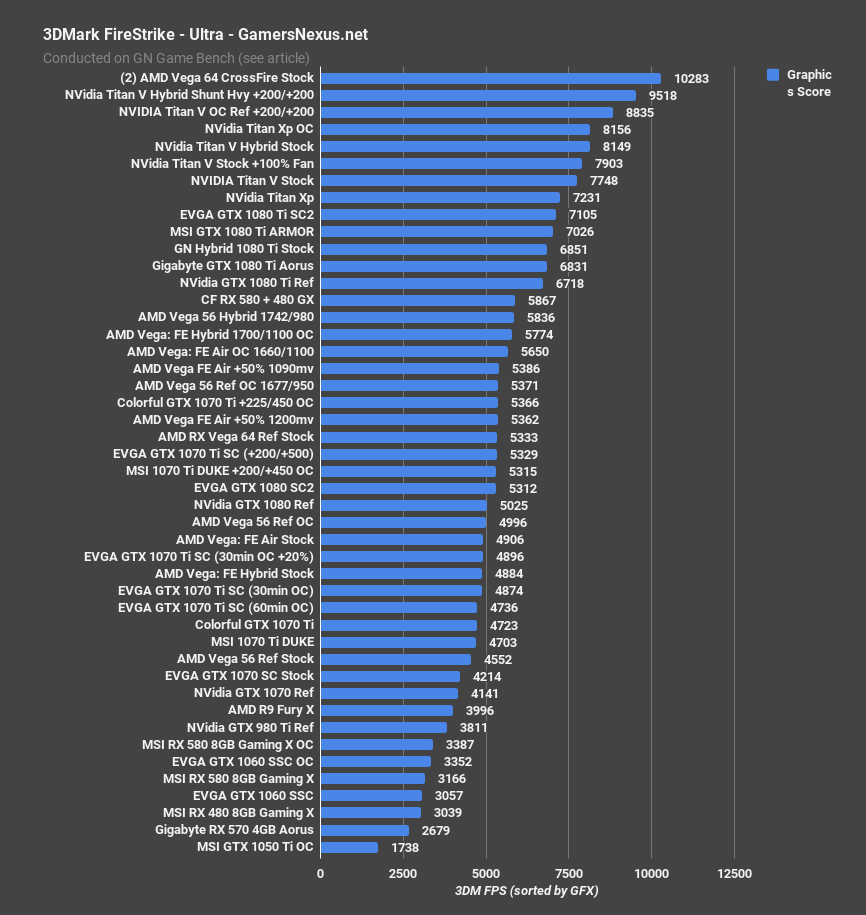We recently bought the MSI GTX 1070 Ti Duke for a separate PC build, and decided we’d go ahead and review the card while at it. The MSI GTX 1070 Ti Duke graphics card uses a three-fan cooler, which MSI seems to now be officially calling the “tri-frozr” cooler, and was among the more affordable GTX 1070 Ti cards on the market. That reign has ended as GPU prices have re-skyrocketed, but perhaps it’ll return again to $480. Until then, we’ll write this assuming that price. Beyond $480, it’s obviously not worth it, just to spell that out right now.
The MSI GTX 1070 Ti Duke has one of the thinner heatsinks of the 10-series cards, and a lot of that comes down to card form factor: The Duke fits in a 2-slot form factor, but runs a three-fan cooler. This mixture necessitates a thin, wide heatsink, which means relatively limited surface area for dissipation, but potentially quieter fans from the three-fan solution.
NOTE: We wrote this review before CES. Card prices have since skyrocketed. Do not buy any 1070 Ti for >$500. This card was reviewed assuming a $470-$480 price-point. Anything more than that, it's not worth it.
A Reminder on How GPUs Work
Our focus here is on thermals and noise, with some minor build quality and value focus. The focus is not, however, on gaming: That was done in our GTX 1070 Ti review, featuring the Colorful Vulcan X 1070 Ti. Gaming performance does not appreciably change between same-GPU video cards to begin with, and that’s especially the case with the 1070 Ti – they all have the same clocks. Any differences in performance are resultant of silicon quality variance, and is not something that the board partners (e.g. MSI, EVGA) control. All performance between same-model 10-series cards is, again, within variance of quality. There is zero point to testing gaming performance a second time, particularly when we can confirm performance with quick synthetic tests.
There’s also limited point to testing overclocking limitations, as up until hardmods, you’re more likely to encounter (again) silicon quality differences prior to relevance of VRM or PCB design. Have no doubt: Bad VRM or PCB designs can absolutely inhibit OC support, but we’re talking “average and up,” here, not “outright garbage.” Those designs would be discussed separately, if they were encountered.
MSI 1070 Ti DUKE Design
We previously tore-down the Duke 1070 Ti, found here:
Of note, the Duke primarily consists of a 2-slot cooler with an extra-thin finstack – hardly the diameter of the heatpipes in its width. The cooler does struggle a bit to keep up with heat load, but adding an extra fan (and some width) somewhat counters this. Somewhat. The card seems to spec relatively low-noise, low-speed fans, even at 100% speeds. Otherwise, the board is using Vishay (Siliconix) parts, as detailed in the above video content.
GPU Test Methodology
| GN Test Bench 2017 | Name | Courtesy Of | Cost |
| Video Card | This is what we're testing | - | - |
| CPU | Intel i7-7700K 4.5GHz locked | GamersNexus | $330 |
| Memory | GSkill Trident Z 3200MHz C14 | Gskill | - |
| Motherboard | Gigabyte Aorus Gaming 7 Z270X | Gigabyte | $240 |
| Power Supply | NZXT 1200W HALE90 V2 | NZXT | $300 |
| SSD | Plextor M7V Crucial 1TB | GamersNexus | - |
| Case | Top Deck Tech Station | GamersNexus | $250 |
| CPU Cooler | Asetek 570LC | Asetek | - |
BIOS settings include C-states completely disabled with the CPU locked to 4.5GHz at 1.32 vCore. Memory is at XMP1. Driver version 388.09 is used for the 1070 Ti.
We communicated with both AMD and nVidia about the new titles on the bench, and gave each company the opportunity to ‘vote’ for a title they’d like to see us add. We figure this will help even out some of the game biases that exist. AMD doesn’t make a big showing today, but will soon. We are testing:
- Ghost Recon: Wildlands (built-in bench, Very High; recommended by nVidia)
- Sniper Elite 4 (High, Async, Dx12; recommended by AMD)
- For Honor (Extreme, manual bench as built-in is unrealistically abusive)
- Ashes of the Singularity (GPU-focused, High, Dx12)
- DOOM (Vulkan, Ultra, 0xAA, Async)
Synthetics:
- 3DMark FireStrike
- 3DMark FireStrike Extreme
- 3DMark FireStrike Ultra
- 3DMark TimeSpy
For measurement tools, we’re using PresentMon for Dx12/Vulkan titles and FRAPS for Dx11 titles. OnPresent is the preferred output for us, which is then fed through our own script to calculate 1% low and 0.1% low metrics (defined here).
MSI GTX 1070 Ti DUKE Thermals
Starting with a complete stock, auto test for out-of-the-box thermals, we measured the GTX 1070 Ti DUKE at about 49 degrees Celsius over ambient – again, that’s delta T over ambient – for the GPU diode reading. This was during our standardized power virus torture test. The MOSFETs operated at about 51 degrees Celsius over ambient, with the hottest GDDR5 module measured at 65 degrees. For the MOSFET and memory measurements, we are using K-type thermocouples that are 1/100th of an inch thick for direct component contact.
We don’t have many 1070 Ti cards tested yet, but these measurements place the MSI DUKE markedly behind the only other 1070 Ti on our bench, the Colorful Vulcan X. The Vulcan X operated about 8 degrees cooler on the GPU, 2-3 degrees cooler for the MOSFETs, and about 3-4 degrees warmer for the memory. The Vulcan X had an unimpressive baseplate and VRAM cooling solution, so these numbers make sense. The Duke is one of the warmest cards on the bench, and part of the reasoning is because MSI’s fan profile in VBIOS isn’t aggressive enough, and the fans are weak to begin with.
During auto testing, the fans tend to stick around 38-42% speed, which has them at about 30dBA of noise. That’s way too conservative. We’ve noticed that MSI seems to target about 66 degrees Celsius for the core temperature, and so they are adjusting fan speeds based on that target. This means that memory can sometimes run warm, as the fans don’t need to spin very fast for GPU cooling, but VRAM doesn’t have any governance over fan speeds.
Here are some noise-normalized numbers, with thermals tested at 40dBA normalized noise levels for all tested cards. The eye-catching thing here is that thermal performance improved when set to a 40dBA output, which is untrue for nearly every other card. This happens for only one reason: The fans are faster at 40dBA, despite 40 decibels being generally on the lower-end of video card noise emissions.
The Duke performs about 8 degrees warmer than the Vulcan X when both are at 40dBA, with a GPU temperature of 45.4C delta T over ambient. We’re also seeing a MOSFET temperature of 45 degrees on the MSI Duke card, about the same as what the Vulcan X saw, and a 58-degree memory temperature, whereas Colorful ran at 64 degrees.
Noise
Speaking of noise, here’s a look at that. Noise levels show the MSI 1070 Ti Duke toward the very bottom edge of the pack when at each RPM level. Most graphics cards like to keep their fans at around 50-55% -- we’ll highlight that now – and use that as a hard target in VBIOS. The MSI card’s fans don’t spin very fast, and tend to max out at around 3300RPM. They are admittedly quiet, but also ineffective at cooling. Again, considering 40dBA was a faster speed than auto, the tuning is much different from most cards on the market.
Overclocking
| Peak Clock (MHz) | AVG Clock (MHz) | Core Offset (MHz) | MEM CLK (MHz) | MEM Offset (MHz) | Power Target | Fan | TMP | Pass/Fail |
| 1898 | 1835 | 0 | 2003.4 | 0 | 100 | 31% | 66 | P |
| 1898 | 1848 | 0 | 2003.4 | 0 | 120 | 100% | 65 | P |
| 1962 | 1936 | 100 | 2003.4 | 0 | 120 | 100% | 65 | P |
| 2012 | 1974 | 150 | 2003.4 | 0 | 120 | 100% | 66 | P |
| 2038 | 2012 | 175 | 2003.4 | 0 | 120 | 100% | 66 | P |
| 2063 | 2038 | 200 | 2003.4 | 0 | 120 | 100% | 66 | P |
| 2088 | 2050 | 225 | 2003.4 | 0 | 120 | 100% | 66 | P |
| 2114 | - | 250 | 2003.4 | - | 120 | 100% | 66 | F - Driver Crash |
| 2088 | 2050 | 225 | 2202 | 400 | 120 | 100% | 66 | P |
| 2088 | 2050 | 225 | 2249 | 500 | 120 | 100% | 66 | P (Fail Testing) |
| 2088 | 2050 | 225 | 2304 | 600 | 120 | 100% | 62 | F - Driver Crash |
As for overclocking, here’s our overclock stepping chart. We found the MSI Duke card to be stable briefly at 225MHz core and 500MHz memory, but ultimately began crashing in games with those frequencies, so we had to step-down to 200MHz core and 450MHz memory. The clock averaged about 2050MHz in this configuration, which is one part power limit and one part thermal limit. Pascal increases clock speed for roughly every 5 degrees Celsius, and if the Duke card were capable of cooling itself below 62-66 degrees in our room ambient of 22C, we’d see a couple MHz higher clock. We also ended up peaking at around 2088MHz, though hit 2114MHz for about half a second before crashing. That was with a 250MHz offset.
| Peak Clock (MHz) | AVG Clock (MHz) | Core Offset (MHz) | MEM CLK (MHz) | MEM Offset (MHz) | Power Target | Fan | TMP | Pass/Fail |
| 1898 | 1873 | 0 | 2003.4 | 0 | 100 | 1300 | 65 | P |
| 1898 | 1873 | 0 | 2003.4 | 0 | 134 | 1700 | 66 | P |
| 1962 | 1962 | 100 | 2003.4 | 0 | 134 | 2800 | 66 | P |
| 2038 | 2038 | 150 | 2003.4 | 0 | 134 | 2800 | 55 | P |
| 2063 | 2038 | 175 | 2003.4 | 0 | 134 | 2800 | 58 | P |
| 2114 | 2063 | 200 | 2003.4 | 0 | 134 | 2800 | 60 | P |
| 2126 | 2088 | 225 | 2003.4 | 0 | 134 | 2800 | 61 | P |
| 2126 | - | 250 | 2003.4 | 0 | 134 | 2900 | 61 | F |
| 2126 | 2114 | 225 | 2227.5 | 450 | 134 | 2900 | 52 | P |
| 2126 | 2088 | 225 | 2227.5 | 450 | 134 | 2900 | 60 | P |
Here’s our Colorful Vulcan X OC table. For this one, we got stuck at around 2088MHz stable average clock, or 2126MHz peak frequency. The result is better for the Vulcan X, and the resulting performance in Firestrike, shown here with Firestrike Ultra, comes out to 5366 points versus 5315 points for graphics. Firestrike Extreme has us about 200 points different as well, favoring the Colorful card.
Conclusion
The card is fine. At $480, it is fairly priced, accessible, and generally acceptable in its cooling performance. This isn’t the best card on the market – not even the best at the price – but it’s OK. Everything is average. Unfortunately, though, the entire market exploded post-2017, and we’re back to completely unreasonable prices on every graphics card. This means that it is largely impossible to offer alternatives and comparisons, as the price-points don’t make any sense, and are generally a rip-off. At $700+, you’d be a fool to buy a GTX 1070 Ti. Find it towards $480, and it’s not a bad buy. EVGA, ASUS, and Colorful have good models in the space, but it’s a question of whose prices fall first, and to what point they fall.
Editorial, Testing: Steve Burke
Video: Andrew Coleman
